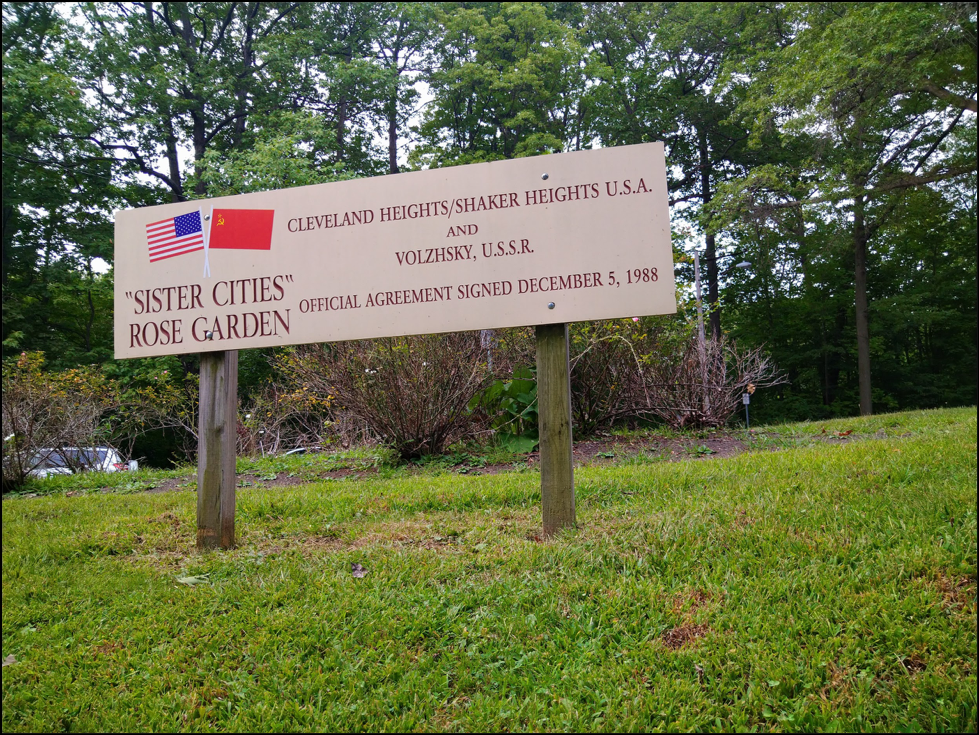Pictured Above is a sign commemorating the sister city relationship between Volzhsky, Shaker Heights, and Cleveland Heights; this relationship was eventually merged with the Volgograd-Cleveland sister city program to form the Greater Cleveland – Volgograd Oblast Alliance
Immigration, ‘My Kind of Town’ and a Rose Garden
– By Ezra Ellenbogen
Cleveland has many sister cities, in fact, Cleveland has 23 sister cities.[1] To put that in perspective, Washington DC has 15 sister cities[2], Detroit has 11 sister cities[3], and Boston has 11.[4] In short, we have a lot of sister cities. Despite this, one sister city stands out among Cleveland’s many: Volgograd, Russia. Not only has the sister city relationship flourished, even going on to include Shaker Heights, Cleveland Heights, and Volzhsky (Russia), but the relationship between the cities has helped the Russian culture in Northeast Ohio thrive, making our Russian population[5]feel at home. Recently, the Gagarin Gala helped highlight the numerous Russian cultural contributions to Cleveland as well as celebrating our long-standing partnership with the Volgograd Oblast.
Cleveland and its partnership with Volgograd have made historic strides in the past towards bringing the US and Russia (which was engulfed in the USSR throughout most of the relationship) together. Early immigration to Cleveland included many Russians, and their initial settlement was accompanied by other Eastern European groups (Finns, Poles, etc.).[6] Soon, Cleveland’s Russian immigrants were a major part of the city’s ethnic composition.
Russian cultural influence in Cleveland picked up in the early 1900s, with famous Russian performers like Anna Pavlova coming to visit. Cleveland’s large Russian population meant that the 1917 Revolution had an effect on Cleveland itself. The political disagreements in Cleveland had to do with Russia’s Bolshevik Revolution and rising interest in anarchism. Cleveland’s May Day Riots came at a time of great unrest in the city. This all was caused not only by the disagreement on the political situation back in Russia but also as a result of the First Red Scare and the US’s legal actions taken against many activists. The combination of labor activism and new interests in socialism saw Charles Ruthenberg gain 30% of the mayoral vote in Cleveland. As a result of the May Day riots, Russian immigration to Cleveland increased, and as the events began to blow over, it was clear that the cultural impact of the new Russian population was significant.[7]
Despite the rising tensions between the US and the USSR, culture from Cleveland traveled to Russia and culture from Russia traveled to Cleveland. These exchanges helped ease tensions between the two countries. After the US began to work more with the USSR, two of Cleveland’s leading engineering companies -Arthur G. Mckee & Co. and the Austin Company- contributed to the construction of new Soviet projects, namely the creation of a new industrial city (Magnitogorsk) and an idealist worker’s paradise (Avtozavod), accompanied by the construction of a large automobile factory. This collaboration between the US and the USSR helped encourage their later partnership in World War II and helped to delay Cold War tensions. However, during the Cold War, Cleveland gained minor missile bases.[8]
As the Soviet Union expanded into Eastern Europe, refugees fled worldwide, and many of them came to Cleveland. The most notable group were the Hungarians, who contributed to Cleveland’s culture greatly. As worry increased about the Cold War, people in Cleveland began to call for an easing of relations. Cleveland capitalists began to influence the USSR, helping to influence Krushchev towards cooperation with the US. Krushchev and his advisors gave a gift (specifically, a troika – a Russian sleigh pulled by three horses) of appreciation to Cyrus Eaton, the Cleveland activist who helped spur the movements to cooperate with the USSR. A famous moment occurred when Anastas Mikoyan, Krushchev’s top advisor, became emotional at the sight of Cleveland’s Terminal Tower when he was visiting the city and stated: “Now you’re talking! This is my kind of town!” Cleveland culture was brought to places all throughout the USSR, mostly through the Cleveland Orchestra’s Eisenhower-approved concerts. The Soviet Union returned the favor by offering the rights to a reportedly outstanding opera, which was performed by the Cleveland Orchestra in Severance Hall in 1935.
In 1985, Cleveland established a sister city partnership with Volgograd, Russia as a result of the cultural contributions of the Russian population in the area had already made and the many collaborations between Russia and Cleveland.[9] Then, a wondrous architectural feat was accomplished, namely: Tremont’s St. Theodosius Russian Orthodox Cathedral. This cathedral is an architectural masterpiece and is one of the best representations of Russian cultural contributions to major cities in the United States. The new structure highlighted the capabilities of the Russian population in Cleveland and helped move the sister city relationship forward.
Then, as Shaker Heights and Cleveland Heights began to worry about the Cold War and what effects it could have if it was not de-escalated, they signed an agreement with Volzhsky, Russia as sister cities in 1988 (both suburbs were sister cities to Volzhsky). A sign and rose garden were placed at the East end of Horseshoe Lake in Shaker Heights to celebrate the momentous development in Cleveland’s history of cooperating with Russia and helping the US do the same, specifically the involvement between Shaker Heights, Cleveland Heights, and Volzhsky. The sign and the rose garden are living legacies of this historic sister city relationship. The sign and the garden still stand today right next to the very popular Horseshoe Park – (the “Sister Cities” Rose Garden is pictured at the top of the article).
Ten years later, Cleveland’s partnership with Volgograd, Shaker Heights’ partnership with Volzhsky, and Cleveland Heights’ partnership with Volzhsky were combined to form the Greater Cleveland Volgograd Oblast Alliance (GCVOA).
The GCVOA provided much more than just a sister city relationship. The GCVOA established not only humanitarian aid, professional training, and mutual infrastructure help as services for Volgograd and Volzhsky, but also a Free Speech Forum for the Russian population. The Volgograd-based Free Speech Forum in Russia was patterned after the City Club of Cleveland. Medical help and aid were provided to the region in Russia, mostly through instruction and some visits. Cultural exchange was also important to the program.[10]
This year has seen many great developments in the sister city relationship. From May 1-3rd, Global Cleveland hosted their Inaugural Sister Cities Conference, with the largest delegation there coming from Volgograd. The GCVOA has made plans to re-engage the relationship between Greater Cleveland and the Volgograd area, including free speech discussions and a delegation from Cleveland visiting Volgograd.
On May 3rd, 2019, the city of Cleveland, in cooperation with the Russian population, held the first Russian Community Day. Not only did this celebration help highlight Russian culture thrive once again, but it will also be an annual endeavour. Russian music, ballet, and food was celebrated in Cleveland City Hall. The event did an amazing job of embracing the GCVOA’s goals as well as creating a demonstration of the thriving Russian cultural presence in Cleveland. Mayor Frank Jackson’s idea for “Russian Community Day” will continue on as a legacy for Cleveland’s culture.
And most recently, the Gagarin Gala was hosted by the Russian Cultural Garden group at Great Lakes Science Center, in celebration of a new Yuri Gagarin sculpture in the Russian Cultural Garden and historical contributions made by Cleveland’s Russian population. Pietro Shakarian spoke about the history of Cleveland’s Russian population and brought attention to the many achievements of Cleveland’s partnerships with Russia over the years. Events like this bring Cleveland together, letting our many ethnic groups flourish. The sister city program and its ambitions will allow for Cleveland’s Russian population to feel at home. This historic sister city relationship will continue to have major political and cultural implications in the future and will help Cleveland and its Russian population thrive.
The Russian population of Cleveland has contributed immensely to the local culture and our sister city relationship that came as a result of this helped to provide real political dialogue between the US and the USSR. Events like this show how immigration can shape the world.
Ezra’s blog: One Page Stories
[1] https://www.clevelandfoundation.org/2019/05/inaugural-sister-cities-conference-welcomes-23-international-communities-to-cleveland/
[2] https://os.dc.gov/service/dc-sister-cities
[3] http://en.sistercity.info/sister-cities/Detroit.html
[4] https://www.boston.gov/economic-development/sister-cities
[5] http://worldpopulationreview.com/us-cities/cleveland-population/
[6] https://case.edu/ech/articles/cleveland-russian-relations
[7] https://case.edu/ech/articles/m/may-day-riots
[8] https://case.edu/ech/articles/n/nike-missile-bases
[9] Gagarin Gala Event Handout


